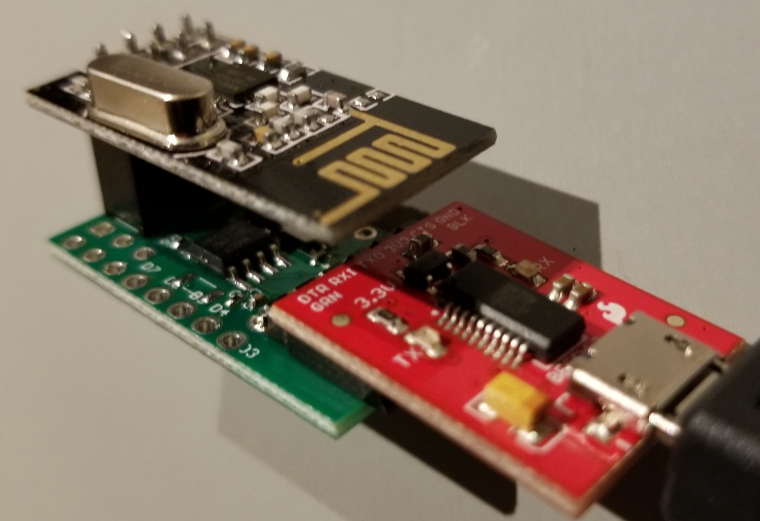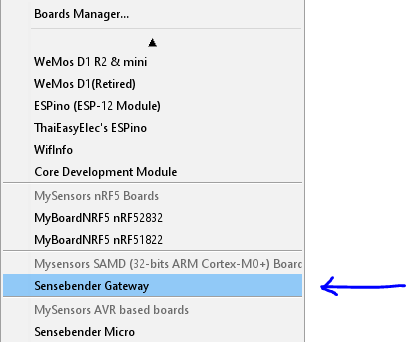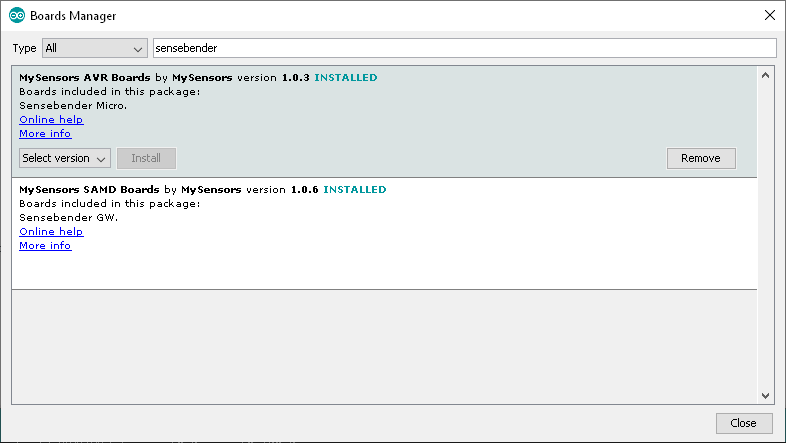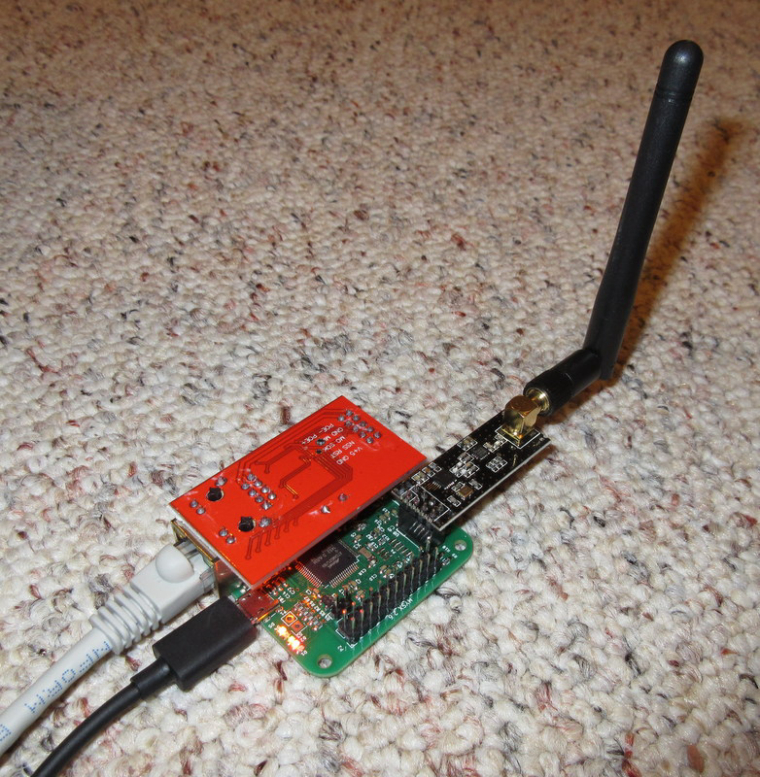💬 Sensebender Gateway
-
I see in logs, that the whole process of signing and communicating to the node takes a bit more than one second. I do not know how to make a stress test properly, so I hoped that somebody else did it :) my question is if gateway will handle load by putting messages in some pipeline, or I should try to make sure that messages are fired with some spaces.
-
I see in logs, that the whole process of signing and communicating to the node takes a bit more than one second. I do not know how to make a stress test properly, so I hoped that somebody else did it :) my question is if gateway will handle load by putting messages in some pipeline, or I should try to make sure that messages are fired with some spaces.
-
im trying to program in arduino ide, installed board... bu when compiling it write mi an error 'The current selected board needs the core 'arduino:arduino' that is not installed.'
-
im trying to program in arduino ide, installed board... bu when compiling it write mi an error 'The current selected board needs the core 'arduino:arduino' that is not installed.'
-
-
@dklinkman said in 💬 Sensebender Gateway:
Sensebender
And I got a Sensebender Micro soldered up and running also!! Just temp and humid so far. Too cool
--edit-- picture

-
This post is deleted!
-
Yes it is! I use I'm using it as a MQTT gateway for some time
-
First: Great work! My GW is working very well!
I wanted to know for what I can use the SD-Card.
My idea is to fetch the logs in the serial and write them to the SD-Card.
But I don't know where. Is there a point in the mySensors core where I can fetch all logs? -
Forgive me if this isn't the right place to ask; but as a beginner, where do I start? How can I order this thing, or any other stuff from OpenHardware.io ? I see so many design files, I'm not sure what to do with them. Soldering the thing I can probably manage, but is there a guide available how to order the PCB, and maybe the parts as well?
-
Forgive me if this isn't the right place to ask; but as a beginner, where do I start? How can I order this thing, or any other stuff from OpenHardware.io ? I see so many design files, I'm not sure what to do with them. Soldering the thing I can probably manage, but is there a guide available how to order the PCB, and maybe the parts as well?
@rolandow said in 💬 Sensebender Gateway:
Forgive me if this isn't the right place to ask; but as a beginner, where do I start? How can I order this thing, or any other stuff from OpenHardware.io ? I see so many design files, I'm not sure what to do with them. Soldering the thing I can probably manage, but is there a guide available how to order the PCB, and maybe the parts as well?
Sesnebender GW can be ordered from Itead:
https://www.itead.cc/mysensors-gateway.html
Other openhardware.io projects maybe ordered either (1) directly from a link; pcb only (2) you can download eagle files and upload them to pcb manufactures like oshpark.com (3) you can purchase the final product. So a generic answer to your question is it depends :)
I do not think there is a guide here, but if you go to oshpark.com there is a guide how to order a pcb. Parts (BOM) can be ordered from Aliexpress, eBay or more reputable supplies like digi-key or mouser
-
Hi!
I'm trying to use sensebender GW as ethernet gateway. I loaded the stock W5100 sketch compiled with samd 1.6.21 defs but it didn't worked. I have been trying out different things and realized that it works with 1.6.12 defs. Now it's working but I'm stuck with an old version. Anyone with the same problem? Maybe I'm missing something?
Also I found out ethernet library in 1.0.5 defs is outdated. I have been trying to use stock one (v2.0) without success. Anyone has tried?
Thanks. -
hi
when i try compile sketch only with change radio to rfm69hw i have this:
Arduino:1.8.9 (Windows 10), Płytka:"Arduino/Genuino Mega or Mega 2560, ATmega2560 (Mega 2560)"SensebenderGatewaySerial:95:26: error: 'LED_BLUE' was not declared in this scope
static uint8_t leds[] = {LED_BLUE, LED_RED, LED_GREEN, LED_YELLOW, LED_ORANGE};
^SensebenderGatewaySerial:95:36: error: 'LED_RED' was not declared in this scope
static uint8_t leds[] = {LED_BLUE, LED_RED, LED_GREEN, LED_YELLOW, LED_ORANGE};
^SensebenderGatewaySerial:95:45: error: 'LED_GREEN' was not declared in this scope
static uint8_t leds[] = {LED_BLUE, LED_RED, LED_GREEN, LED_YELLOW, LED_ORANGE};
^SensebenderGatewaySerial:95:56: error: 'LED_YELLOW' was not declared in this scope
static uint8_t leds[] = {LED_BLUE, LED_RED, LED_GREEN, LED_YELLOW, LED_ORANGE};
^SensebenderGatewaySerial:95:68: error: 'LED_ORANGE' was not declared in this scope
static uint8_t leds[] = {LED_BLUE, LED_RED, LED_GREEN, LED_YELLOW, LED_ORANGE};
^C:\Users\Piotrek\Desktop\SensebenderGatewaySerial-sketch\SensebenderGatewaySerial\SensebenderGatewaySerial.ino: In function 'void preHwInit()':
SensebenderGatewaySerial:116:10: error: 'MY_SWC1' was not declared in this scope
pinMode(MY_SWC1, INPUT_PULLUP);
^SensebenderGatewaySerial:117:10: error: 'MY_SWC2' was not declared in this scope
pinMode(MY_SWC2, INPUT_PULLUP);
^SensebenderGatewaySerial:130:17: error: 'LED_BLUE' was not declared in this scope
digitalWrite(LED_BLUE, led_state); ^SensebenderGatewaySerial:145:16: error: 'LED_GREEN' was not declared in this scope
digitalWrite(LED_GREEN, HIGH);
^SensebenderGatewaySerial:149:16: error: 'LED_YELLOW' was not declared in this scope
digitalWrite(LED_YELLOW, HIGH);
^SensebenderGatewaySerial:154:16: error: 'LED_ORANGE' was not declared in this scope
digitalWrite(LED_ORANGE, HIGH);
^SensebenderGatewaySerial:167:17: error: 'LED_RED' was not declared in this scope
digitalWrite(LED_RED, HIGH); ^C:\Users\Piotrek\Desktop\SensebenderGatewaySerial-sketch\SensebenderGatewaySerial\SensebenderGatewaySerial.ino: In function 'bool testSDCard()':
SensebenderGatewaySerial:219:33: error: 'MY_SDCARD_CS' was not declared in this scope
if (!card.init(SPI_HALF_SPEED, MY_SDCARD_CS)) {
^C:\Users\Piotrek\Desktop\SensebenderGatewaySerial-sketch\SensebenderGatewaySerial\SensebenderGatewaySerial.ino: In function 'bool testEEProm()':
SensebenderGatewaySerial:249:2: error: 'SerialUSB' was not declared in this scope
SerialUSB.print(" -> EEPROM ");
^
C:\Users\Piotrek\Desktop\SensebenderGatewaySerial-sketch\SensebenderGatewaySerial\SensebenderGatewaySerial.ino: In function 'bool testAnalog()':
SensebenderGatewaySerial:267:30: error: 'MY_BAT_DETECT' was not declared in this scope
int bat_detect = analogRead(MY_BAT_DETECT);
^exit status 1
'LED_BLUE' was not declared in this scopeWhat is error ? please help me
-
-
hi
when i try compile sketch only with change radio to rfm69hw i have this:
Arduino:1.8.9 (Windows 10), Płytka:"Arduino/Genuino Mega or Mega 2560, ATmega2560 (Mega 2560)"SensebenderGatewaySerial:95:26: error: 'LED_BLUE' was not declared in this scope
static uint8_t leds[] = {LED_BLUE, LED_RED, LED_GREEN, LED_YELLOW, LED_ORANGE};
^SensebenderGatewaySerial:95:36: error: 'LED_RED' was not declared in this scope
static uint8_t leds[] = {LED_BLUE, LED_RED, LED_GREEN, LED_YELLOW, LED_ORANGE};
^SensebenderGatewaySerial:95:45: error: 'LED_GREEN' was not declared in this scope
static uint8_t leds[] = {LED_BLUE, LED_RED, LED_GREEN, LED_YELLOW, LED_ORANGE};
^SensebenderGatewaySerial:95:56: error: 'LED_YELLOW' was not declared in this scope
static uint8_t leds[] = {LED_BLUE, LED_RED, LED_GREEN, LED_YELLOW, LED_ORANGE};
^SensebenderGatewaySerial:95:68: error: 'LED_ORANGE' was not declared in this scope
static uint8_t leds[] = {LED_BLUE, LED_RED, LED_GREEN, LED_YELLOW, LED_ORANGE};
^C:\Users\Piotrek\Desktop\SensebenderGatewaySerial-sketch\SensebenderGatewaySerial\SensebenderGatewaySerial.ino: In function 'void preHwInit()':
SensebenderGatewaySerial:116:10: error: 'MY_SWC1' was not declared in this scope
pinMode(MY_SWC1, INPUT_PULLUP);
^SensebenderGatewaySerial:117:10: error: 'MY_SWC2' was not declared in this scope
pinMode(MY_SWC2, INPUT_PULLUP);
^SensebenderGatewaySerial:130:17: error: 'LED_BLUE' was not declared in this scope
digitalWrite(LED_BLUE, led_state); ^SensebenderGatewaySerial:145:16: error: 'LED_GREEN' was not declared in this scope
digitalWrite(LED_GREEN, HIGH);
^SensebenderGatewaySerial:149:16: error: 'LED_YELLOW' was not declared in this scope
digitalWrite(LED_YELLOW, HIGH);
^SensebenderGatewaySerial:154:16: error: 'LED_ORANGE' was not declared in this scope
digitalWrite(LED_ORANGE, HIGH);
^SensebenderGatewaySerial:167:17: error: 'LED_RED' was not declared in this scope
digitalWrite(LED_RED, HIGH); ^C:\Users\Piotrek\Desktop\SensebenderGatewaySerial-sketch\SensebenderGatewaySerial\SensebenderGatewaySerial.ino: In function 'bool testSDCard()':
SensebenderGatewaySerial:219:33: error: 'MY_SDCARD_CS' was not declared in this scope
if (!card.init(SPI_HALF_SPEED, MY_SDCARD_CS)) {
^C:\Users\Piotrek\Desktop\SensebenderGatewaySerial-sketch\SensebenderGatewaySerial\SensebenderGatewaySerial.ino: In function 'bool testEEProm()':
SensebenderGatewaySerial:249:2: error: 'SerialUSB' was not declared in this scope
SerialUSB.print(" -> EEPROM ");
^
C:\Users\Piotrek\Desktop\SensebenderGatewaySerial-sketch\SensebenderGatewaySerial\SensebenderGatewaySerial.ino: In function 'bool testAnalog()':
SensebenderGatewaySerial:267:30: error: 'MY_BAT_DETECT' was not declared in this scope
int bat_detect = analogRead(MY_BAT_DETECT);
^exit status 1
'LED_BLUE' was not declared in this scopeWhat is error ? please help me
@pepson said in 💬 Sensebender Gateway:
hi
when i try compile sketch only with change radio to rfm69hw i have this:
Arduino:1.8.9 (Windows 10), Płytka:"Arduino/Genuino Mega or Mega 2560, ATmega2560 (Mega 2560)"SensebenderGatewaySerial:95:26: error: 'LED_BLUE' was not declared in this scope
You cannot use the SensebenderGatewaySerial sketch on an Atmega2560. The SensbenderGatewaySerial sketch is for the SAMD board called Sensebender Gateway.
If you have the real Sensebender Gateway you should use this one

-
@pepson said in 💬 Sensebender Gateway:
hi
when i try compile sketch only with change radio to rfm69hw i have this:
Arduino:1.8.9 (Windows 10), Płytka:"Arduino/Genuino Mega or Mega 2560, ATmega2560 (Mega 2560)"SensebenderGatewaySerial:95:26: error: 'LED_BLUE' was not declared in this scope
You cannot use the SensebenderGatewaySerial sketch on an Atmega2560. The SensbenderGatewaySerial sketch is for the SAMD board called Sensebender Gateway.
If you have the real Sensebender Gateway you should use this one

-
@pepson said in 💬 Sensebender Gateway:
@magpern
But get this board to Arduino IDE?Boards / Boards manager...
search for sensebender

You might have to
File / Preferences / Additional Board manager URLs
add
https://raw.githubusercontent.com/mysensors/ArduinoBoards/master/package_mysensors.org_index.json -
Hi
I compiled and write to gateway this programmm. Then i connected it to my RPI with Hassio (Home Assistant). In logs on home assistant still show me info: Gateway /dev/serial/by-id/usb-MySensors.org_Sensebender_GW_6A153443514D355934202020FF10182D-if00 not ready after 15.0 secs so continuing with setupbut after run Home Assistant gateway works ok. I send info mto developer Home Assistant ans she not see any bugs....
How i can resolved this problem ?

